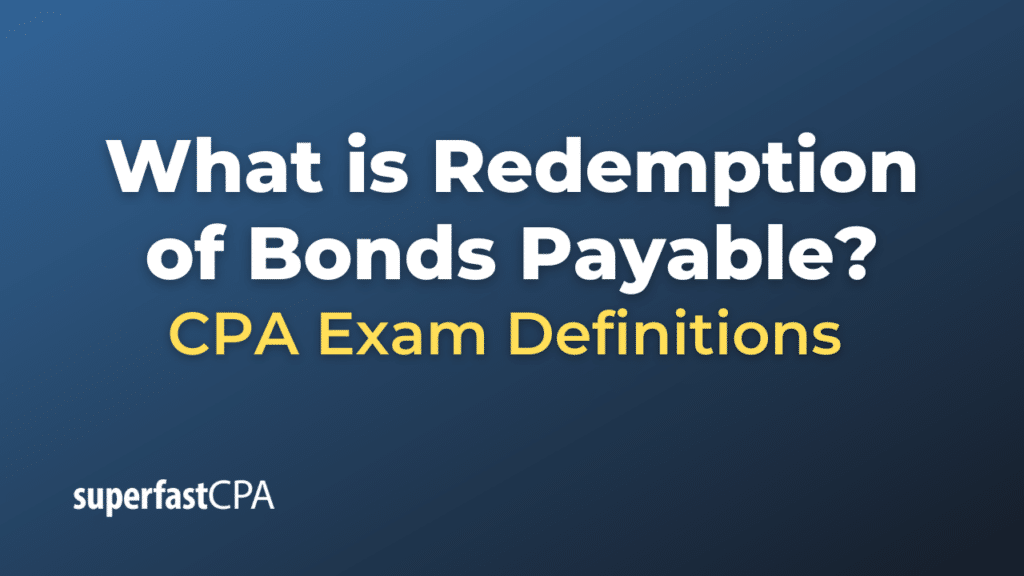Redemption of Bonds Payable
“Redemption of Bonds Payable” refers to the process by which a company repays or “redeems” its bondholders upon the maturity of the bonds or due to a call provision. When a company issues bonds, it is essentially borrowing money from investors with a promise to repay the principal amount (face value) at a specified maturity date, along with periodic interest payments until that date.
There are several ways or circumstances in which bonds can be redeemed:
- Maturity Redemption: This is the most straightforward method. When the bond reaches its stated maturity date, the issuer pays back the face value or principal amount of the bond to the bondholders.
- Callable Bonds : Some bonds have call provisions, which allow the issuer to redeem the bonds before their maturity date. The terms of the call feature, including when the bonds can be called and at what price, are specified in the bond indenture. Issuers might exercise this option when prevailing interest rates decrease, allowing them to refinance their debt at a lower cost.
- Convertible Bonds: These are bonds that can be converted into a specified number of common stock shares of the issuing company. When bondholders choose to convert their bonds, the liability related to those bonds is removed from the company’s balance sheet as they’re exchanged for equity.
- Sinking Fund Redemption : Some bond indentures require the issuing company to set aside a certain amount of money regularly into a “sinking fund.” This fund is used to redeem a portion of the bond issue periodically, before the maturity date. It helps the company spread out the redemption and lessen the burden of repaying a large sum all at once.
- Purchase in the Open Market: If a company has excess cash and its bonds are trading at a discount in the open market, it might decide to buy back its bonds at a price lower than the face value, effectively realizing a gain.
Accounting for Redemption of Bonds Payable:
When a company redeems bonds, the accounting will typically involve:
- Removing the Bonds Payable Liability: The face value of the bonds is removed from the liability section of the balance sheet.
- Paying Cash : The company reduces its cash balance by the amount paid to redeem the bonds.
- Recording Interest Expense: If the redemption occurs between interest payment dates, the company will need to pay any accrued interest to bondholders and recognize it as interest expense.
- Recognizing Gain or Loss: If the bonds are redeemed for an amount different than their carrying amount (e.g., if there are call premiums or if they’re bought back at a discount in the open market), the company will recognize a gain or loss on the redemption.
To conclude, the redemption of bonds payable is a significant activity for companies as it relates to their capital structure and long-term financing strategy. Proper accounting ensures that stakeholders understand the company’s financial position and performance related to its debt obligations.
Example of Redemption of Bonds Payable
Let’s delve into a fictional example to understand the redemption of bonds payable better.
BlueTech Inc., a tech company, issued callable bonds five years ago with a 10-year maturity and a face value of $1,000,000, carrying an interest rate of 6% per annum. Due to favorable market conditions and a drop in prevailing interest rates to 4%, BlueTech decides to call and redeem these bonds after five years. The bond indenture specifies a call premium of 2% of the face value.
Steps for Redemption:
- Announce Redemption : BlueTech notifies bondholders of its intent to redeem the bonds in accordance with the terms set out in the bond indenture.
- Pay Off Bondholders:
- Principal Amount: $1,000,000
- Call Premium (2% of $1,000,000): $20,000
- Total Redemption Amount: $1,020,000
- Accounting for Redemption:
When the redemption date arrives, BlueTech will make the following journal entries:- Debit Bonds Payable: $1,000,000 (To remove the liability of the bonds from the books)
- Debit Premium on Redemption: $20,000 (To record the call premium)
- Credit Cash: $1,020,000 (To reflect the cash payment made to bondholders)
If there’s any accrued interest at the time of redemption, BlueTech would also need to account for that by debiting Interest Expense and crediting Cash for the appropriate amount.
By redeeming the bonds, BlueTech has taken advantage of lower interest rates in the market. They might now consider issuing new bonds at the current lower interest rate of 4%, effectively refinancing their debt at a cheaper rate. Bondholders, on the other hand, receive their principal back earlier than expected, along with the call premium as compensation for the early redemption.
This example illustrates how the redemption process works and the associated accounting entries. It’s worth noting that in real-life scenarios, additional factors and complexities could arise.













